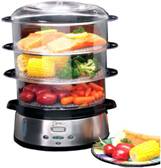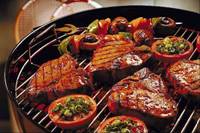

![]()
![]()
Cooking methods
There are a whole range of cooking methods that are used, cooking it to ensure the food is tenderised, tasty, nutritious and safe to eat
Baking
When we cook food in this way it means surrounding it with a heat in an enclosed environment. It is a semi dry heat that browns well but is not as efficient as boiling in terms of heat transfer. This name is mostly applied nowadays to pastry and bread cookery. Microwave
It is a fast method of cooking, causes fluid loss and does not of itself produce browning. Micro waving within a closed container such as a plastic bag (which must be vented to avoid explosion!) is similar to steaming. Steaming This is cooking in water vapour – usually over boiling water, however stock or moist dishes such as stews may serve as the base over which other ingredients are cooked by being suspended in some form of perforated dish. The equipment comprises a saucepan with one or more steaming baskets with close fitting lid. BBQ In the UK this refers to cooking the food on a grill over burning charcoal. Flavour may be imparted to the meat by the burning charcoal or wood chips or herbs may be burnt on the charcoal to give additional flavour. To give flavour a marinade is also used. Casserole This word is a combination of method and utensil – Casserole is the name of the lidded container in which the ingredients are cooked. The dish is usually served at table in this dish. It differs from a stew only in that a stew is traditionally cooked on the hob and a casserole in the oven. Grill, griddle pan It is a quick, dry and very hot cooking method for tender meat in small or thin portions, which may be marinated beforehand. The griddle pan enable the fat juices to run off, and be removed before serving. Poaching
This is generally taken to mean cooking in a liquid which is simmering the surface of the water will be just moving at about 90-96ºC. Stir frying
This is achieved in a Wok, over high heat with minimal fat or oil, which is almost smoking. Food is cut into small pieces and different foods added sequentially according to their cooking needs, the ingredients are kept constantly on the move by tossing. Moistening ingredients or sauces are added at the end of the cooking period and the food is served immediately.
|
Portion Size
We are within a society of large and super size portions being the norm, and it is often hard to know how much you should be eating per day. The food standards agency has devised an eat well plate for visual representation of what you plate should look like.
The plates illustrates the proportion of all the nutrients including fat, carbohydrates, protein, and fruits and vegetables that you should be consuming per day The majority needs to be made up of carbohydrates, and also fruits and vegetables with a portion or protein of either meat, egg or fish and the least proportion is from fats and sugars.
Food labeling Food labeling can often be confusing and you are left wondering is this product really any good? In order to make this easier for consumers to identify the key ingredients and therefore how healthy the product is the labeling traffic light system was introduced. The food standards agency devised traffic light labeling system this consists of low, medium and high proportions Per 100g. It is important to monitor the amount of fat, saturated fat, salt and sugar especially in food. The different level for the nutrient and the values are represented in the table below:
Often food products are indicated with the traffic light colours, green representing low, amber medium and red high. This creates it easy for the consumer to quickly see on a product. Below are some examples that are found on food products, ideally you are wanting the majority of green codes. If the product contains high amount of amber and red then this should be considered a treat and not eaten everyday to avoid weight gain and health affects.
For more information visit the food standards agency
Tips for cutting down fat
Most of the vitamin and minerals are located underneath the skin. So when you peel a vegetable you are already losing vitamins and minerals before you've even started to cook it! Try to keep the skin on for example potato's baked in the oven with the skin and much healthier when compared to peeled chips. Depending on the cooking method used, also effects the vitamin and mineral content. For example using s steamer retains the large part of the vitamin and minerals content whereas a microwave heats the products so quickly due to the high powerful heat in a short period of time actually creates vitamin and minerals loss. |











